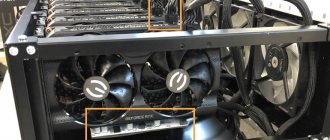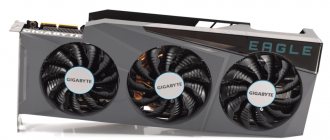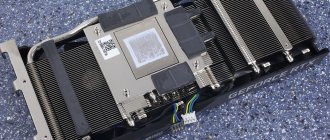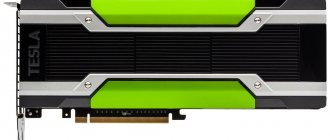Sound cards, TV tuners, internal fax modems, additional USB and FireWire controllers, ATA controllers for connecting additional disks and drives, network cards and other expansion cards are also connected via PCI.
PCI Express (PCIe, PCI-e) is a new standard for a high-speed serial computer expansion bus with high bandwidth and a small number of pins. It was designed to replace the old PCI and AGP. PCIe has many improvements over older standards, including higher maximum system bus bandwidth, fewer I/O pins and smaller slot size, better performance scaling for bus devices, more detailed error detection and reporting mechanism, and built-in hot-swappable functionality.
The PCI Express architecture delivers I/O performance for desktop platforms with transfer rates starting at 2.5 gigabytes per second over the x1 PCI Express lane. See the picture for details.
PCI-E is a serial bus that uses two low-voltage differential LVDS pairs at 2.5 Gbps in each direction—one transmit pair and one receive pair. The pinout of all types of connectors of this standard is given in the tables below.
Additional power for video adapter
There are 2 types of video card power supply:
- Standard - connects via PCI slot (power up to 75 W)
- Additional - via a 6 pin connector (additional 75 W) or 8 pin (additional 150 W power).
Older models are designed for standard power supply only. The 6 pin connector has 3 lower pins allocated for additional voltage (+12 W) and 3 upper pins for grounding.
The connector has 8 pins: from the lower left bayonet, the first 3 elements are designed for increased voltage. The remaining parts are reserved for grounding.
The graphics card is equipped with a connector for increased power supply (1-4 pcs.). Connectors are connected to them, through which energy is transmitted. By increasing power, the speed of the computer increases.
PCI connector pinout
| Pin | Name | Description | Pin | Name | Description |
| A1 | TRST | Test Logic Reset | B1 | -12V | -12 VDC |
| A2 | +12V | +12 VDC | B2 | TCK | Test Clock |
| A3 | TMS | Test Mode Select | B3 | GND | Ground |
| A4 | TDI | Test Data Input | B4 | TDO | Test Data Output |
| A5 | +5V | +5 VDC | B5 | +5V | +5 VDC |
| A6 | INTA | Interrupt A | B6 | +5V | +5 VDC |
| A7 | INTC | Interrupt C | B7 | INTB | Interrupt B |
| A8 | +5V | +5 VDC | B8 | INTD | Interrupt D |
| A9 | — | Reserved | B9 | PRSNT1 | Present |
| A10 | +5V | Power (+5 V or +3.3 V) | B10 | — | Reserved |
| A11 | — | Reserved | B11 | PRSNT2 | Present |
| A12 | GND03 | Ground or Keyway for 3.3/Universal PWB | B12 | GND | Ground or Keyway for 3.3/Universal PWB |
| A13 | GND05 | Ground or Key-way for 3.3/Universal PWB | B13 | GND | Ground or Open (Key) for 3.3/Universal PWB |
| A14 | 3.3Vaux | — | B14 | RES | Reserved |
| A15 | RESET | Reset | B15 | GND | Ground |
| A16 | +5V | Power (+5 V or +3.3 V) | B16 | CLK | Clock |
| A17 | GNT | Grant PCI use | B17 | GND | Ground |
| A18 | GND08 | Ground | B18 | REQ | Request |
| A19 | PME# | Power Management Event | B19 | +5V | Power (+5 V or +3.3 V) |
| A20 | AD30 | Address/Data 30 | B20 | AD31 | Address/Data 31 |
| A21 | +3.3V01 | +3.3 VDC | B21 | AD29 | Address/Data 29 |
| A22 | AD28 | Address/Data 28 | B22 | GND | Ground |
| A23 | AD26 | Address/Data 26 | B23 | AD27 | Address/Data 27 |
| A24 | GND10 | Ground | B24 | AD25 | Address/Data 25 |
| A25 | AD24 | Address/Data 24 | B25 | +3.3V | +3.3VDC |
| A26 | IDSEL | Initialization Device Select | B26 | C/BE3 | Command, Byte Enable 3 |
| A27 | +3.3V03 | +3.3 VDC | B27 | AD23 | Address/Data 23 |
| A28 | AD22 | Address/Data 22 | B28 | GND | Ground |
| A29 | AD20 | Address/Data 20 | B29 | AD21 | Address/Data 21 |
| A30 | GND12 | Ground | B30 | AD19 | Address/Data 19 |
| A31 | AD18 | Address/Data 18 | B31 | +3.3V | +3.3 VDC |
| A32 | AD16 | Address/Data 16 | B32 | AD17 | Address/Data 17 |
| A33 | +3.3V05 | +3.3 VDC | B33 | C/BE2 | Command, Byte Enable 2 |
| A34 | FRAME | Address or Data phase | B34 | GND13 | Ground |
| A35 | GND14 | Ground | B35 | IRDY# | Initiator Ready |
| A36 | TRDY# | Target Ready | B36 | +3.3V06 | +3.3 VDC |
| A37 | GND15 | Ground | B37 | DEVSEL | Device Select |
| A38 | STOP | Stop Transfer Cycle | B38 | GND16 | Ground |
| A39 | +3.3V07 | +3.3 VDC | B39 | LOCK# | Lock bus |
| A40 | SMBCLK | SMB CLK | B40 | PERR# | Parity Error |
| A41 | SMBDAT | SMB DATA | B41 | +3.3V08 | +3.3 VDC |
| A42 | GND17 | Ground | B42 | SERR# | System Error |
| A43 | PAR | Parity | B43 | +3.3V09 | +3.3 VDC |
| A44 | AD15 | Address/Data 15 | B44 | C/BE1 | Command, Byte Enable 1 |
| A45 | +3.3V10 | +3.3 VDC | B45 | AD14 | Address/Data 14 |
| A46 | AD13 | Address/Data 13 | B46 | GND18 | Ground |
| A47 | AD11 | Address/Data 11 | B47 | AD12 | Address/Data 12 |
| A48 | GND19 | Ground | B48 | AD10 | Address/Data 10 |
| A49 | AD9 | Address/Data 9 | B49 | GND20 | Ground |
| A50 | Keyway | Open or Ground for 3.3V PWB | B50 | Keyway | Open or Ground for 3.3V PWB |
| A51 | Keyway | Open or Ground for 3.3V PWB | B51 | Keyway | Open or Ground for 3.3V PWB |
| A52 | C/BE0 | Command, Byte Enable 0 | B52 | AD8 | Address/Data 8 |
| A53 | +3.3V11 | +3.3 VDC | B53 | AD7 | Address/Data 7 |
| A54 | AD6 | Address/Data 6 | B54 | +3.3V12 | +3.3 VDC |
| A55 | AD4 | Address/Data 4 | B55 | AD5 | Address/Data 5 |
| A56 | GND21 | Ground | B56 | AD3 | Address/Data 3 |
| A57 | AD2 | Address/Data 2 | B57 | GND22 | Ground |
| A58 | AD0 | Address/Data 0 | B58 | AD1 | Address/Data 1 |
| A59 | +5V | Power (+5 V or +3.3 V) | B59 | VCC08 | Power (+5 V or +3.3 V) |
| A60 | REQ64 | Request 64 bit | B60 | ACK64 | Acknowledgment 64 bit |
| A61 | VCC11 | +5 VDC | B61 | VCC10 | +5 VDC |
| A62 | VCC13 | +5 VDC | B62 | VCC12 | +5 VDC |
| 64 bit spacer KEYWAY | |||||
| 64 bit spacer KEYWAY | |||||
| A63 | GND | Ground | B63 | RES | Reserved |
| A64 | C/BE[7]# | Command, Byte Enable 7 | B64 | GND | Ground |
| A65 | C/BE[5]# | Command, Byte Enable 5 | B65 | C/BE[6]# | Command, Byte Enable 6 |
| A66 | +5V | Power (+5 V or +3.3 V) | B66 | C/BE[4]# | Command, Byte Enable 4 |
| A67 | PAR64 | Parity 64 | B67 | GND | Ground |
| A68 | AD62 | Address/Data 62 | B68 | AD63 | Address/Data 63 |
| A69 | GND | Ground | B69 | AD61 | Address/Data 61 |
| A70 | AD60 | Address/Data 60 | B70 | +5V | Power (+5 V or +3.3 V) |
| A71 | AD58 | Address/Data 58 | B71 | AD59 | Address/Data 59 |
| A72 | GND | Ground | B72 | AD57 | Address/Data 57 |
| A73 | AD56 | Address/Data 56 | B73 | GND | Ground |
| A74 | AD54 | Address/Data 54 | B74 | AD55 | Address/Data 55 |
| A75 | +5V | Power (+5 V or +3.3 V) | B75 | AD53 | Address/Data 53 |
| A76 | AD52 | Address/Data 52 | B76 | GND | Ground |
| A77 | AD50 | Address/Data 50 | B77 | AD51 | Address/Data 51 |
| A78 | GND | Ground | B78 | AD49 | Address/Data 49 |
| A79 | AD48 | Address/Data 48 | B79 | +5V | Power (+5 V or +3.3 V) |
| A80 | AD46 | Address/Data 46 | B80 | AD47 | Address/Data 47 |
| A81 | GND | Ground | B81 | AD45 | Address/Data 45 |
| A82 | AD44 | Address/Data 44 | B82 | GND | Ground |
| A83 | AD42 | Address/Data 42 | B83 | AD43 | Address/Data 43 |
| A84 | +5V | Power (+5 V or +3.3 V) | B84 | AD41 | Address/Data 41 |
| A85 | AD40 | Address/Data 40 | B85 | GND | Ground |
| A86 | AD38 | Address/Data 38 | B86 | AD39 | Address/Data 39 |
| A87 | GND | Ground | B87 | AD37 | Address/Data 37 |
| A88 | AD36 | Address/Data 36 | B88 | +5V | Power (+5 V or +3.3 V) |
| A89 | AD34 | Address/Data 34 | B89 | AD35 | Address/Data 35 |
| A90 | GND | Ground | B90 | AD33 | Address/Data 33 |
| A91 | AD32 | Address/Data 32 | B91 | GND | Ground |
| A92 | RES | Reserved | B92 | RES | Reserved |
| A93 | GND | Ground | B93 | RES | Reserved |
| A94 | RES | Reserved | B94 | GND | Ground |
Why you should not install a video adapter with increased power supply
- Saving electricity . If the components operate in standard mode, without overloads, energy consumption is minimal. Having extra power will have a big impact on your electricity bills, especially if your PC is used regularly.
- Price . A graphics card with additional power supply is much more expensive than standard devices. If great functionality is needed, the high cost is acceptable, but, more often than not, such technical characteristics are not fully worthwhile. Here, everything depends on the user and his preferences.
- Device load . If high performance of the video adapter is required, it is better to install a device with high power consumption. However, if you purchase a low-quality device, there is a risk of rapid failure. Cheap models cannot withstand the high load that occurs when the power supply increases.
- Distribution of electricity between components . If the factory configuration of your PC is not initially designed for a powerful power source for the video card, you will have to change some components before connecting it. Increasing the power supply to the graphics card disrupts the power distribution throughout the system. This can cause devices to overload and fail. To prevent this, it is necessary to calculate the energy consumption of all components and assess the condition of the devices.
- Uselessness . Increased power supply is necessary for high video adapter performance. This function is necessary in the following cases: development and testing of computer games with high graphics; editing photo and video files; watching high quality videos; working with programs that require high video card performance (the necessary parameters are indicated in the instructions). Increased power supply is required for professional activities related to image quality on a computer. Perhaps a high performance will be needed for PC gamers who require a powerful graphics card. In other cases, the increased parameters will be superfluous, since they are not used. Unknowing users want to increase the performance of the device for the sake of authority in the computer field, although they do not need this function.
Disadvantages of a graphics card without powerful power consumption
- Inability to work with some programs . All computer services operate under certain technical specifications. The necessary parameters are indicated in the instructions during downloading and installation. If the program is designed to work with graphics, the performance of a video adapter with standard power supply will not be enough. The service does not open and displays an access error.
- Work intermittently . If the required performance differs slightly from the standard, the program can run. However, during operation, all parameters increase, which leads to failures. The service takes a long time to complete basic tasks and does not load some subroutines. Working in this mode does not bring positive results. If such operation is regular, the device will soon fail, or some data will be erased from memory. In the worst case, the problem will affect other programs and the entire computer.
- Games . Almost all modern games are designed for powerful technical characteristics. In order for the graphics and response speed to user actions to be at the proper level, it is necessary to take care of the PC components and their parameters in advance. If the computer was not originally intended for gaming, you will have to replace some devices. Without powerful power, the graphics card will not be able to cope with the load, which will lead to negative consequences: interruptions and freezes of the game; overheating of the video card and other components; restarting the game without saving the progress; partial or complete failure.
Is it worth installing a video adapter without additional power?
Computers designed to perform standard basic tasks do not have high technical characteristics . If you plan to work with programs that require greater performance, you must use a graphics card with an improved power system.
If the user does not work with powerful programs, does not develop or test computer games, or does not process graphic data (photos, videos), a video card with a powerful power supply is not required.
Before purchasing, you need to think about the purpose for which you are purchasing powerful hardware. If you change components without thinking through the choice, the decision will entail large expenses and problems during the operation of the PC.
2018-10-09Published 10/9/2018 author Andrey Andreev
— 2 comments
Hello friends! You, of course, already know that powerful video cards consume a lot of energy, and therefore require an appropriate power supply on the computer. Today I will talk about video card power connectors and why they are used.
No additional power supply
Naturally, not a single graphics accelerator can work without it - after all, it is a complex design consisting of many chips and logical blocks.
The main power consumers in a video card are the graphics accelerator, video memory and cooling system (if active), and to a lesser extent all other components.
Budget graphics cards do not have outstanding power, although they cope well with office tasks and therefore do not consume a lot of energy. In addition, they usually have a passive cooling system - just a radiator, without a cooler.
To power such a device, the voltage supplied via the PCI‑E interface is sufficient, and no additional electricity is needed - 75 Watts from the motherboard is quite enough.
When assembling such a computer, you can limit yourself to a low-power unit - no more than 400 W. As a rule, this power is enough to provide energy to all components.
In addition, workhorses usually rarely undergo upgrades, so that in 5 or 10 years they will be able to run the programs necessary for work.
This does not apply to PCs used in design studios or design bureaus: running Photoshop or AutoCad requires a more powerful computer, often with a good graphics card.
With additional
They sometimes, and on gaming computers, almost always use powerful video cards, which often require additional power, since the voltage supplied through the connection interface is not enough.
This need can be determined by the appearance of the video card: on the reverse side (most often) of the PCI‑E connector they have a slot for additional power supply. If the card is quite powerful, but does not have a connector for additional power, then it is simply not required.
Today you can see the following slots:
- 6 pin – older version and less powerful;
- 8 pin - appeared relatively recently, differs in the supply of higher voltage.
Without going into details, in the end we get that the six-pin connector supplies 75 Watts, and the eight-pin connector supplies 150 Watts. Are there any options? There are, but more about them below.
Voltage and color marking of cables
In order to bring to a single standard and minimize errors during installation and connection, it is customary to use wires with the appropriate insulation color for each voltage. This helps you quickly navigate when diagnosing your computer. The voltage wires are marked by color:
- 0 V (ground, common wire) – black;
- +5 volts – red;
- -5 volts – white;
- +12 volts – yellow;
- +3.3 volts – orange;
- -12 volts – blue.
Voltages not used to power computer components (control signals, etc.) use different colors, even if the voltage levels are the same as shown. Even little-known electronics manufacturers from Southeast Asia adhere to these standards. Another thing is that their color marking often makes it impossible to distinguish orange from yellow or red, and sometimes black from blue or purple.
A little about blocks
Budget Chinese power supplies, created on the knee in Grandfather Liao's basement (such, unfortunately, still come across), have one bad property: the number of “zero” wires in them does not always correspond to the standard pinout.
Accordingly, the power of such a unit may turn out to be less than declared, and in terms of reliability they do not shine - if you manage to operate such a device for at least a year, consider yourself very lucky.
And now I’m gradually bringing you, friends, to the worst thing: top-end video cards don’t have enough power, even an 8-pin connector. For example, the GTX 1080 Ti consumes 250 Watts and requires one six-pin and one eight-pin connector to connect it. That's why such devices have two connectors.
When selecting components, you should pay attention to what connectors are on the video card and whether the power connectors on the wires coming from the power supply correspond to them.
You should also know that there is a so-called “universal” 6+2 pin connector. It has 6 pins, grouped monolithically, as a single block, and two more can be connected using a special latch.
What to do if you bought components, but it turned out that the power supply does not have the required plug? You can always purchase a special adapter with a SATA or Molex connector - at least one cable, in most cases, will remain free.
Which one you connect through the adapter does not matter: the same power is supplied to them.
I would like to draw your attention to the fact that when assembling a computer, the main thing is not the presence of connectors on the power supply, but its power: it should be enough to provide energy to all components of the computer.
And if you are assembling a computer “for the future,” it is better to take a power supply with a power reserve - it remains to be seen what upgrade it will undergo in a couple of years and what video card you will use at that time.
For a deeper understanding of the topic, I advise you to read the publications “Choosing the right video card according to the parameters for a computer”, as well as “Connectors for computer video cards: video connectors and on the motherboard”. You can read about where it is better to buy components for the system unit here.
Thank you for your attention and see you next time on the pages of my blog! Don't forget to share this article on social networks and subscribe to the newsletter!
Sincerely, blog author Andrey Andreev
2020-10-07Published 10/7/2020 author Andrey Andreev
—
Hello everyone! Many PC users are wondering: a video card with or without additional power - which is better and why, whether its presence is good or bad, what are the pros and cons on each side and is there a fundamental difference.
Today I will try to give the most complete answers to these and similar questions. You can read about how to connect additional power to the GPU here.
Notebook-specific
It’s worth saying a few words about rare, I would even say “exotic” connectors that are found in laptops or some other devices, but which cannot be found on a regular PC. These are two connectors: PCMCIA (ExpressCard) and Kensington Lock. The latter is used to protect the device from theft. A special cord with a lock is inserted into the “Kensington Lock” connector and tied to any object, be it a table or a battery, for example. Naturally, only you have the keys to the castle.
But the “ExpressCard” is a narrow slot covered with a plug into which a certain expansion card is inserted, on which ports for connecting other devices can be placed. With the help of such a card, you can easily add some USB 3.0 ports to your laptop, if only because there is a shortage of them on any laptop.
View Queue
Queue
- delete everything
- Disable
Features of the PCI‑E port
Almost all modern video cards that are used in the system unit are connected via the PCI‑E port on the motherboard. Regardless of its version, which affects the data transfer speed, this slot can power the device with up to 75 Watts.
Is this too much? Not much, but enough to provide energy for an entry-level gaming video adapter - for example, Nvidia GeForce GTX 1050 Ti or AMD R7 350. Most brands produce such models without a slot (connector) for additional power supply.
The layout of more powerful video adapters, such as the GTX 1560, may already differ. You will find devices of different brands on sale. Some require additional power supply, others do not.
Powerful video cards always require additional power supply.
Molex connector
Initially, this connector was designed to power hard drives and floppy drives, but currently for modern devices this function is performed by SATA connectors (about them below), and Molex connectors are used to power various additional equipment.
The advantage of Molex is the presence of 5 and 12 Volt lines at the same time, and a current of up to 11 Amps can flow through each line, that is, the power of a 12-Volt line is 132 Watts, and a 5-Volt line is 55 Watts. You can often find information on the Internet that Molex provides 187 watts of power. This is true, but the additional power connector for video cards has only 12 Volt lines, and the 5 Volt line is not used. In mining rigs, Molex connectors are used to connect risers, cooling fans, additional power to the motherboard, and as a replacement for missing PCI-E connectors.











